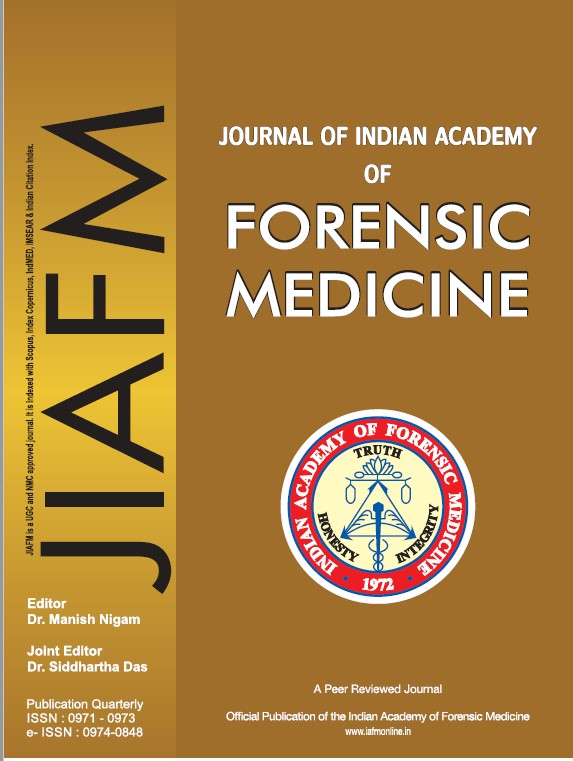Study of Cephalic Index and its correlation with Sex and Race in Central India
DOI:
https://doi.org/10.48165/jiafm.2024.46.1.15Keywords:
Race, Anthropology, Cephalic index, Head length, Head breadthAbstract
The technique of expressing quantitatively the form of the human body, living or dead and also skeleton is anthropometry. In the world, all human beings belong to the same species, Homo sapiens. Any two individuals are not the same in all their measurable traits, even there are differences in the genetically identical twins in some respects. For estimating sex and race, cephalofacial measurements and indices are useful like the cephalic index or cranial index. 3-4 racial groups are organized by anthropologists based on skull categorization methods. India falls in this craniofacial measurements group's as considered by Thomas Huxley. Asian skulls are brachycephalic with wide faces having flat supranasal regions and facial flatness. Craniofacial type of Australoids fall between Negroids and Caucasoids. The study was conducted on 196 medical students (92 males and 104 females). Hardlika's method was used to measure the cephalic index. The mean cephalic index was 79.71 ± 4.55 in males and in females it was 83.14 ± 7.69. Irrespective of gender the mean cephalic index of overall study was found to be 81.53 ± 6.62. Based on cephalic index, 45.65% males were dolicocephalic, 31.52% mesocephalic, 15.22% brachycephalic and 7.61% hyperbrachycephalic. In females, 46.15% were dolicocephalic, 33.65% mesocephalic, 10.58% brachycephalic and 9.62% hyperbrachycephalic.
Downloads
References
MBT Umar, AS Ojo, SAAsala, JO Hambolu. Comparison of Cephalometric Indices Between the Hausa and Yoruba Ethnic Groups of Nigeria. Research J. of Medical Sciences. 2011; 5(2): 83-89.
Shema K. Nair, Vaibhav P. Anjankar, Singh S, Bindra M, Satpathy DK. The Study of Cephalic Index of Medical Students of Central India. Asian Journal of Biomedical and Pharmaceutical Sciences. 2014; 04 (28): 48-50.
Shah GV, Jadhav HR. The Study of Cephalic index in Students of Gujarat. J Anat Soc India. 2004; 53 (1): 25-26.
Pandey N, Jha CB, Yadav G, Sah SK, Yadav P, Awasthi J. Study of cephalic index in nepalese medical students. Int J Anat Res. 2016; 4(4): 3253-3256.
Anitha MR, Vijayanath V, Raju GM, Vijayamahantesh SN. Cephalic Index of North Indian Population. Anatomica Karnataka. 2011; 5(1): Page 40-43.
Mahesh Kumar and Patnaik V.V. Gopichand. The study of Cephalic Index in Haryanvi population. Int. J. Pure App. Biosci. 2013; (3): 1-6.
Shah T, Thaker MB, Menon MK. Assessment of Cephalic and Facial Indices: A proof for Ethnic and Sexual Dimorphism. Journal of Forensic Science & Criminology. 2015; 3(1): 1-11.
rd 8. Hardlika A. Practical Anthropometry. 3 ed. Philadelphia: Wistar Institute;1947: 185-6.
ISSN : 0971 - 0973, e - ISSN : 0974 - 0848
Mahajan A, Khurana BS, Seema, Batra APS. The Study Of Cephalic Index In Punjabi Students. Journal of Punjab Academy of Forensic Medicine & Toxicology; 2009: 9: 66- 70.
Wirginia Likus et al. Cephalic Index in the First Three Years of Life: Study of Children with Normal Brain Development Based on Computed Tomography. The Scientific world Journal; 2014.
Yagain VK, Shakunthala R.Pai, Sneha G. Kalthur, Chethan P, I Hemlatha. Study of cephalic index in Indian students. Int. J. Morphol. 2012; 30(1): 125-129.
Akinbami BO. Measurement of Cephalic Indices in Older Children and Adolescents of a Nigerian Population. BioMed Research International. 2014; Article ID 527473, 1-5. http://dx.doi.org/10.1155/2014/527473.
Priti A. Nemade, Amit S. Nemade. Study Of Cephalic Index In Maharashtra. International Journal of Biological & Medical Research. 2014; 5(3): 4258-4260.
Khanduri et al. Establishment of Cephalic Index Using Cranial Parameters by Computed Tomography in a Sampled North Indian Population. Cureus 13(6): 2021: 1-11. DOI 10.7759/cureus.15421.
Seema & Verma P. The study of cephalic index in north Indian population. Int. J. Morphol. 2016; 34(2): 660-664.
Isurani IIayperuma. Evaluation of cephalic indices: Aclue for racial and sex diversity. Int J Morphol. 2011; 29(1): 112-117.
Ujwala Bhanarkar, Baishakhi Koley. Study of Cephalic Index in medical students of West Bengal. J Indian Acad Forensic Med. 2020; 42(1): 44-45.


